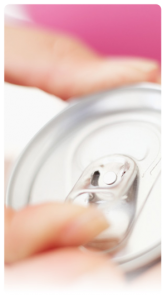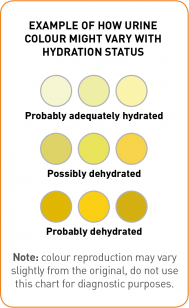Hydration levels
Water needs vary between individuals and according to diet, environmental conditions, activity levels and a range of other factors.
Hydration needs
 Water is lost from the body predominantly via the kidney as urine and via the skin as sweat. These losses vary widely with the amount of fluid intake, diet, activity level, temperature and clothing. Water balance is achieved when losses are compensated by intake from food and beverages plus metabolic water production.
Water is lost from the body predominantly via the kidney as urine and via the skin as sweat. These losses vary widely with the amount of fluid intake, diet, activity level, temperature and clothing. Water balance is achieved when losses are compensated by intake from food and beverages plus metabolic water production.
Water balance normally varies over the course of the day, but is usually regulated to within about 0.2% of the body weight over 24 hours despite the wide variability of food and fluid intake and of water output. Water deficits and excesses trigger compensatory changes in either drinking behaviour or in urine output until water balance is re-established.
Water requirements vary between individuals and according to diet, environmental conditions, activity levels and a range of other factors. Therefore, only adequate intakes can be defined for specific age groups.
The Panel on Dietetic Products, Nutrition and Allergies from the European Food Safety Authority (EFSA)* has issued a Scientific Opinion on Dietary Reference Values for water where the following reference values for total water intake are considered (see table). Note that the amount of water that is deemed adequate includes water from drinking water, beverages of all kind, and from food moisture and only apply to conditions of moderate environmental temperature and moderate physical activity levels.
* EFSA Panel on Dietetic Products, Nutrition, and Allergies (NDA); Scientific Opinion on Dietary reference values for water. EFSA Journal 2010; 8(3):1459. [48 pp.]. doi:10.2903/j.efsa.2010.1459. Available online:www.efsa.europa.eu.
Reference values for total water intake
Age range |
Daily adequate water intake |
|
|---|---|---|
| Infants | ||
| 0-6 months | 680 mL/day or 100-190 mL/kg/day. From human milk | |
| 6-12 months | 0.8-1.0 L/day. From human milk and complementary foods and beverages | |
| 1-2 years | 1.1-1.2 L/day | |
| Children | ||
| 2-3 years | 1.3 L/day | |
| 4-8 years | 1.6 L/day | |
| Adolescents | ||
| 9-13 years – Males | 2.1 L/day | |
| 9-13 years – Females | 1.9 L/day | |
| 14-18 years – Males | 2.5 L/day | |
| 14-18 years – Females | 2.0 L/day | |
| Adults | ||
| 19-70 years – Males | 2.5 L/day | |
| 19-70 years – Females | 2.0 L/day | |
| Special cases | ||
| Pregnant women | 2.3 L/day | |
| Lactating women | 2.7 L/day | |
| Adapted from: EFSA Panel on Dietetic Products, Nutrition, and Allergies (NDA); Scientific Opinion on Dietary reference values for water. EFSA Journal 2010; 8(3):1459. [48 pp.]. doi:10.2903/j.efsa.2010.1459. Available online:www.efsa.europa.eu | ||
Water losses under extreme conditions of external temperature and physical exercise can be up to about 10-12 L/day or even more. These high losses have to be replaced adequately to avoid serious disturbances of water and salt balance.
In cases of severe diarrhoea, water losses can also be very high. Cholera is fortunately rare, but it can lead to severe diarrhoea with up to half of the total body water being lost by this route in a single day. Treatment involves drinking plenty of fluids, especially oral rehydration solutions that can be obtained from a pharmacy. These will replace some of the salts that are being lost along with the water. Isotonic sports drinks may be used if oral rehydration solutions are not readily available.
Intakes of water that are too high cannot be compensated by the excretion of very dilute urine (maximum urine volumes are about 1 L/hour in adults) and can lead to water intoxication, possibly leading to swelling of the brain. This is a serious condition, with occasionally fatal consequences. No maximum daily amount of water that can be tolerated by a population group can be defined without taking into account individual and environmental factors.
Please see our downloadable educational tool about this specific topic
Hints and Tips
How much water may the body lose in one day?
The typical adult living in a temperate climate loses about 2-2.5 litres of water per day in things such as expired breath, sweat, urine and other bodily secretions. The total quantity will depend on gender, body size, weather, clothing worn, activity levels and a whole range of other factors.
We lose water constantly, but drink only intermittently, so the water content of the body is constantly changing.
For the average 80 kg male sitting at rest in a comfortable environment, water losses will typically run at about 300 mL per hour. For the average female who weighs about 65 kg, losses will occur at a slightly slower rate of about 250 mL per hour.
If we accept that a dehydration level of about 1% of body weight is tolerable, that could occur after only about 2-3 hours. So long as we drink adequate amounts at meal times, and at the typical tea/coffee breaks that most of us have, we can stay perfectly well-hydrated throughout the day.
About to take a plane? It is important to know how to stay hydrated
The body tends to dehydrate while travelling, particularly on aeroplanes because air in the cabin is usually much dryer than than the air on earth. When traveling, hydration levels can be maintained by drinking an additional 250 mL per hour.
What’s the weather forecast for today? The weather affects hydration needs
Sweating or perspiring is a skin-cooling system that uses a great deal of water. That’s why sweat losses have to be replaced when we are exposed to high temperatures, such as in the summer or in any other hot environment. It is important to keep an eye on the weather forecast, temperature and humidity in the city or region we live in or we are visiting in order to adjust hydration levels accordingly.
 We have to know how to read the signals our body sends us
We have to know how to read the signals our body sends us
The colour of urine is one of the best ways to recognize dehydration. Therefore, it is important to keep an eye on the colour of urine. Straw coloured urine indicates a good fluid intake; the darker it is, the more you may need to drink. This chart will help you to see how urine colour might vary with hydration status.